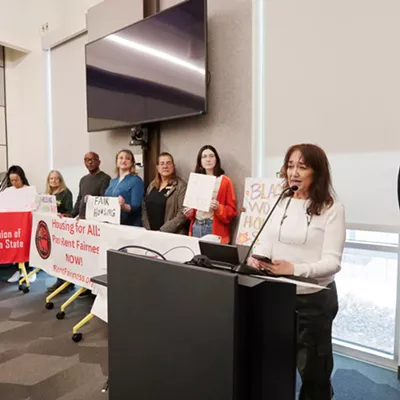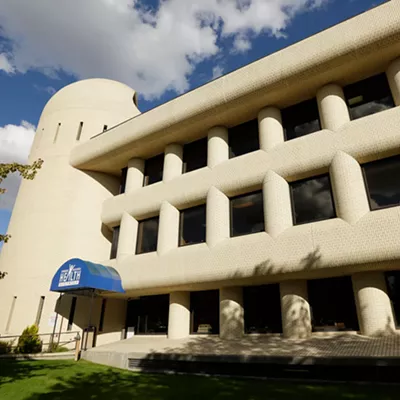When "SARA" sends texts checking in to see how the job and housing search is going for homeless clients, her questions sound natural enough that sometimes people forget she's not a real person.
"She's been invited to dinner many times," says KD Nyegaard, the founder of the Career Index in Coeur d'Alene and creator of SARA.
While not exactly the goal, it's a positive sign that the artificial intelligence assistant is doing her job well, helping handle grunt work for case managers so they can spend more quality time assisting their clients, all in a way that is easy and natural.
With the Career Index, Nyegaard's company helped make things easier for case managers who assist people with finding jobs, specifically through vocational rehabilitation. But they wanted to know: What's the biggest thing preventing those case managers from doing better work?
So they conducted a survey. Hundreds of case managers reported spending as much as 75 to 80 percent of their time entering data and putting case notes into computer systems to maintain files on their clients, he says.
"You can go to any agency and you will see people are at their computers doing documentation. Most of them [have] master's degrees, which is a little nuts," Nyegaard says. "So we thought, 'Hmm, it ought to be possible to develop a system that can do most of that work.'"
Enter SARA. The cloud-based service, which can be programmed to work through virtually any workflow that involves checking in with clients or staff members, takes much of that data-entry work out of day-to-day schedules, Nyegaard says.
She checks in with clients on a regular basis to ask the time-consuming questions a case manager might otherwise have to, he says. The system is already being used by agencies across 10 states to help with everything from vocational rehabilitation programs to Temporary Assistance for Needy Families. Recently, it's been assisting people experiencing homelessness in North Idaho.Since January, as people have come to stay at one of St. Vincent de Paul's two 12-bed shelters for men and women in Coeur d'Alene, they've been enrolled in the program. If they're in need of work, SARA will follow up to see how the job search is going. If they need housing, she'll check on that too.
"It is very tenacious, and it helps hold clients accountable for what they need to do," Nyegaard says. "You can't just say to SARA, 'Well, no I didn't do it.' SARA's going to ask, 'Well why didn't you do it? What's the problem? What's happening?'"
Having a computer system automatically create real-time case notes from interactions with clients has been a major help, says Jeff Conroy, executive director at St. Vincent de Paul.
The digital assistant has the ability to work 24/7, 365 days a year, and it also takes some of the tension out of the relationship between people in the program and their case worker.
"It lets SARA be Mom, 'cause Mom doesn't really care if you're happy, Mom just wants you to be successful, right?" Conroy says. "And it allows that case management session to be about the client. We had one where they spent an hour trying to fix the client's computer. At another they spent an hour looking and helping them find daycare."
Since they started using SARA, the average shelter stay has been cut in half, to 28 days, which is impressive, considering Idaho hopes to keep people in emergency shelters no longer than 57 days, Conroy says. Nationally, the median length of stay in an emergency shelter in 2015 was 27 days, but the average was 68 days, according to the National Alliance to End Homelessness.
Perhaps in an even more powerful statistic, the system has been so persistent that everyone in the emergency shelter this year has found work, Conroy says.
"For the first time in the 10 years I've been here, everyone in the emergency shelter has a job," Conroy says. "It's that accountability piece, that constant: 'Have you got a job yet, have you got a job yet, have you got a job yet?'"
MAKING IT PERSONAL
As soon as anyone leaves one of the shelters run by St. Vincent de Paul, there are usually two people ready to take that empty bed, says Amberly Bunch, case manager for the shelters.
"There's generally people checking each day and we'll have to turn them away 'cause we're full," she says.
For her, being able to get help from SARA, which gives her instant digital access to files and makes sure no one is missed, is huge.
"I've had case managers in my own life sit there five or 10 minutes typing in silence, and it's just so awkward," Bunch says. "So I think that it's just awesome."
She still gets to meet with each client once a week, but SARA enables her to know right away if there's a problem she can quickly help with by text in between meetings. When they do meet, the time is better spent helping people with their individual needs.
One of the most promising services SARA will offer the shelter in the long run is the chance to collect long-form data, Conroy says. Starting this month, she'll be following up with clients a month after they leave the shelter, then again at the six-month and one-year marks to see where things stand.
"I think the piece we're missing, and it's for all social work, is what are they like after you leave?" Conroy says. "I need to see those numbers. It's great we're able to house somebody and get them food and a job. But did it stick?"
COST AND POTENTIAL
SARA is being used for free at St. Vincent de Paul, and also could soon be implemented at Heritage Health, a nonprofit community health center operating locations throughout North Idaho, Nyegaard says. The move to offer those services pro bono came as he wanted to find a way to give back to the local community.
For other users, the cost can vary, depending on the type of system that works best, he says. Some agencies will pay for an annual subscription of sorts, that ranges from $600 to $2,500 per year, per case manager. That allows them to deal with as many clients as they want to. Other systems opt to pay per client, which typically works out to about $15 to $20 per person, Nyegaard says.
Taking into account the cost to pay an assistant, or multiple assistants, to work full time, the system becomes a no-brainer, he says.
While it's already been programmed to work with several job and social service agencies in states like Kentucky, Alaska and Nevada, there are even more promising potential uses for SARA in the future, Nyegaard says.
Maybe it could be used to follow up with people getting out of prison as they go through the re-entry process, making information easily accessible between the numerous agencies that make contact with someone, he says.
Or maybe after a hurricane or other natural disaster, it could be put to use: The company is working with a consultant to explore potential uses in disaster emergency management.
"That is incredibly intensive in terms of the follow-up that has to happen over two to three years, making sure that people get all the permits, paperwork is filled out, the contractors do what they are supposed to do," Nyegaard says. "We've been told something like this would allow them to do that much more efficiently and at the same time get up and going much faster." ♦























